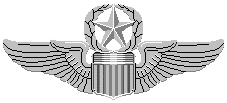| Major
General William Joseph Crumm is commander, 3rd Air Division,
Strategic Air Command. He is responsible for the management,
operational control and employment of all Strategic Air
Command forces in the Western Pacific, including the B-52
bombing missions and all Air Force aerial refueling operations
in support of U.S. operations in Southeast Asia.
General
Crumm was born in New York City in 1919 and attended Scarsdale
High School and the University of Virginia. He entered
military service in 1941, receiving his wings and commission
in 1942 through the flying cadet program.
His
first assignment was with the 91st Bomb Group in the European
Theatre of Operations as a B-17 pilot. He returned to
the United States as a member of the "Most Deserving Bomber
Crew of the 8th Air Force" and lectured at 30 combat crew
training schools and all of the major aircraft factories.
In
May 1943, the general was assigned to the 796th Bomb Squadron,
Alexandria, La., as operations officer, and later the
same year he was assigned to Second Air Force in Colorado
Springs, Colo. In October 1944 General Crumm assumed command
of the 61st Bomb Squadron, Smoky Hill Army Air Base, Kan.,
and shortly after he moved the unit to Guam.
In
1946 he was assigned to the Flying Training Division,
Strategic Air Command, as assistant training officer.
In rapid succession he became chief of the Bomb Section,
deputy of the Training Section and acting chief of the
Training Section.
General
Crumm attended Air Command and Staff School at Maxwell
Air Force Base, Ala., in August 1947. He took command
of the 344th Bomb Squadron, Spokane Air Force Base, Wash.,
in July 1948. In January of the following year he became
director of operations for the 98th Bomb Group at Spokane
Air Force Base.
Moving
to Offutt Air Force Base, Neb., in 1950, General Crumm
was assigned as chief of the Special Projects Division,
Director of Operations, Strategic Air Command. He became
chief of Operational Plans Division, Director of Operations,
Strategic Air Command, in June 1953. He attended B-47
Advanced Flying School at McConnell Air Force Base, Wichita,
Kan., and in October 1954, he was assigned as deputy commander
of the 22d Bomb Wing, March Air Force Base, Calif., and
then as the director of operations for Fifteenth Air Force
also at March.
In
September 1956, General Crumm served as task force commander
at Thule Air Force Base, Greenland. He returned to March
Air Force Base in April 1957 as commander of the 320th
Bomb Wing. In October 1958 he was transferred to the Deputy
Chief of Staff, Operations, Headquarters U.S. Air Force,
Washington, D.C., as chief of the Strategic Division.
He
became chief of the Atomic Operations Division, J-3, Joint
Chiefs of Staff in May 1960. In August of the same year
he was reassigned to Headquarters Strategic Air Command,
Offutt Air Force Base, Neb., as senior Air Force member
on the newly organized staff of the director of strategic
target planning. In June 1962 he became chief of operations
for the director of strategic target planning.
General
Crumm received his present assignment as commander, 3rd
Air Division, Strategic Air Command, Andersen Air Force
Base, Guam, in July 1965.
On
July 7, 1967, two B52 aircraft were enroute to a combat
mission when they collided in mid-air over the South China
Sea. The aircraft were approximately 20 miles offshore
at the point of Vinh Binh Province when the accident occurred.
Seven crewmembers from the aircraft were rescued, but
Avolese, Crumm, Bittenbender, Blankenship, Jones, and
McLaughlin were not.
All
the missing crewmen onboard the two B52 downed that day
were believed to be dead. It is unfortunate, but a cold
reality of war that their remains were not recoverable.
They are listed with honor among the missing because their
remains cannot be buried with honor at home.
The
General wears the wings of command pilot. His decorations
include the Legion of Merit with oak leaf cluster, Distinguished
Flying Cross, Bronze Star Medal, Air Medal with three
oak leaf clusters, Air Force Commendation Medal, and the
Army Commendation Medal with oak leaf cluster.
|







